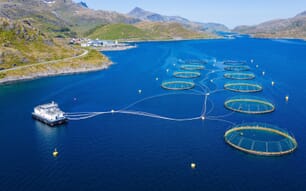The figure follows on from a 4.1% drop the previous year, but 2016’s total is still the fifth highest on record, according to the results of the Scottish Fish Farm Production Survey 2016.
Much like in 2015, the year-on-year fall has been attributed health issues, which led to fish at many sites being harvested earlier than planned. This was reflected by the yield per smolt stocked at sea, which fell to 3.45 kg, the lowest figure since 2007. Likewise the mean weight of harvested fish, which fell to 4.7 kg for fish in their second year, was also the lowest average since 2007; while an average of 4.5 kg for those harvested in year 1, was the lowest achieved since 2011.
The largest mean weights were in Orkney, at 5.3 kg, while the lowest were in the Western Isles at 4.1 kg.
Despite these challenges, the industry expects production to increase to 177,202 tonnes this year, which would make it the second highest total on record, just below the 179,022 tonnes harvested in 2014.
In 2016, marine salmon production was undertaken by 15 businesses farming 253 active sites. This is a decrease of one business and one active site compared with 2015. 82.8% of the salmon produced came from sites with capacities over 1000 tonnes. The total number of staff in marine salmon production in 2016 increased by 123 to 1,486. Organic production, from five certified sites, rose from 2,283 to 3,903 tonnes.
Three escape incidents, resulting in the loss of 311,496 fish, took place in the course of the year.
Freshwater salmon
In 2016, freshwater production of Atlantic salmon was undertaken by 26 businesses at 87 sites. The number of businesses operating increased by one and the number of active sites remained the same as in 2015.
The total number of smolts produced in 2016 decreased by 1,677,000 (4%) to 42.9 million. The number of ova laid down to hatch decreased by 5.6% to 64.3 million, with the majority of these (90.8%) being derived from foreign sources. In 2016, 361,000 ova were exported.
The number of staff employed in freshwater salmon production remained at 294.
Rainbow trout
In 2016, rainbow trout production was carried out by 24 businesses operating 44 active sites, this was one site less than in 2015.
Total production in 2015 decreased by 492 tonnes (6%) to 8,096 tonnes, although this is still the second highest level of rainbow trout production recorded in Scotland.
The number of staff employed in 2015 decreased by five to 121. Productivity, measured as tonnes produced per person, decreased by 1.9% to 66.9.
Other species
In 2016, brown/sea trout production decreased by one tonnes to 41 tonnes while halibut production increased by 11 tonnes to 67 tonnes. Production estimates forecast an increase in brown/sea trout (92 tonnes) and halibut (80 tonnes) in 2017.
262,000 lumpsucker and 118,000 of various species of wrasse were cultured for use as a biological control for parasites in the marine Atlantic salmon industry, with 3.3 million and 5.2 million ova being laid down to hatch respectively. Staff numbers in 2016 increased by 13 to 63 persons.




